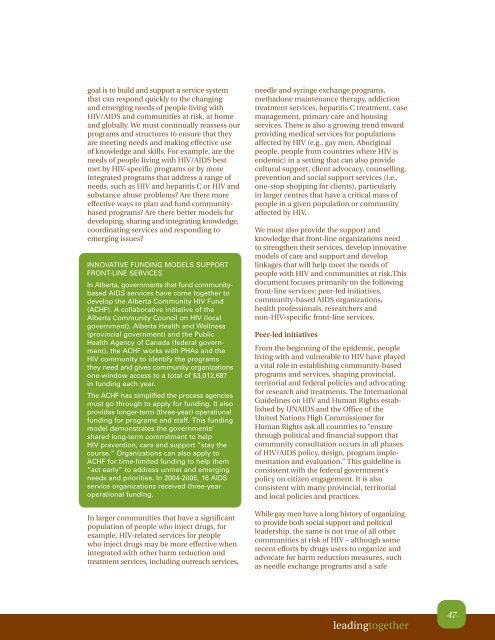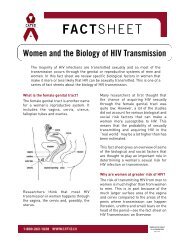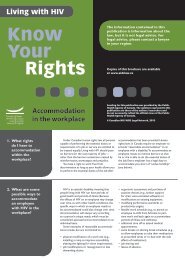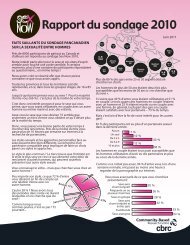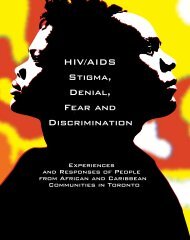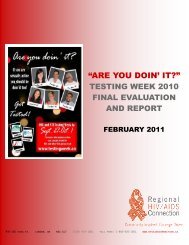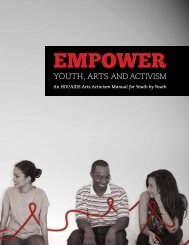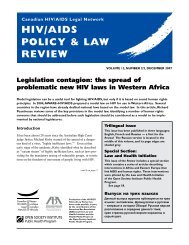leadingtogether: - CATIE
leadingtogether: - CATIE
leadingtogether: - CATIE
- No tags were found...
Create successful ePaper yourself
Turn your PDF publications into a flip-book with our unique Google optimized e-Paper software.
goal is to build and support a service systemthat can respond quickly to the changingand emerging needs of people living withHIV/AIDS and communities at risk, at homeand globally. We must continually reassess ourprograms and structures to ensure that theyare meeting needs and making effective useof knowledge and skills. For example, are theneeds of people living with HIV/AIDS bestmet by HIV-specific programs or by moreintegrated programs that address a range ofneeds, such as HIV and hepatitis C or HIV andsubstance abuse problems? Are there moreeffective ways to plan and fund communitybasedprograms? Are there better models fordeveloping, sharing and integrating knowledge,coordinating services and responding toemerging issues?INNOVATIVE FUNDING MODELS SUPPORTFRONT-LINE SERVICESIn Alberta, governments that fund communitybasedAIDS services have come together todevelop the Alberta Community HIV Fund(ACHF). A collaborative initiative of theAlberta Community Council on HIV (localgovernment), Alberta Health and Wellness(provincial government) and the PublicHealth Agency of Canada (federal government),the ACHF works with PHAs and theHIV community to identify the programsthey need and gives community organizationsone-window access to a total of $3,012,687in funding each year.The ACHF has simplified the process agenciesmust go through to apply for funding. It alsoprovides longer-term (three-year) operationalfunding for programs and staff. This fundingmodel demonstrates the governments’shared long-term commitment to helpHIV prevention, care and support “stay thecourse.” Organizations can also apply toACHF for time-limited funding to help them“act early” to address unmet and emergingneeds and priorities. In 2004-2005, 16 AIDSservice organizations received three-yearoperational funding.In larger communities that have a significantpopulation of people who inject drugs, forexample, HIV-related services for peoplewho inject drugs may be more effective whenintegrated with other harm reduction andtreatment services, including outreach services,needle and syringe exchange programs,methadone maintenance therapy, addictiontreatment services, hepatitis C treatment, casemanagement, primary care and housingservices. There is also a growing trend towardproviding medical services for populationsaffected by HIV (e.g., gay men, Aboriginalpeople, people from countries where HIV isendemic) in a setting that can also providecultural support, client advocacy, counselling,prevention and social support services (i.e.,one-stop shopping for clients), particularlyin larger centres that have a critical mass ofpeople in a given population or communityaffected by HIV.We must also provide the support andknowledge that front-line organizations needto strengthen their services, develop innovativemodels of care and support and developlinkages that will help meet the needs ofpeople with HIV and communities at risk.Thisdocument focuses primarily on the followingfront-line services: peer-led initiatives,community-based AIDS organizations,health professionals, researchers andnon-HIV-specific front-line services.Peer-led initiativesFrom the beginning of the epidemic, peopleliving with and vulnerable to HIV have playeda vital role in establishing community-basedprograms and services, shaping provincial,territorial and federal policies and advocatingfor research and treatments. The InternationalGuidelines on HIV and Human Rights establishedby UNAIDS and the Office of theUnited Nations High Commissioner forHuman Rights ask all countries to “ensurethrough political and financial support thatcommunity consultation occurs in all phasesof HIV/AIDS policy, design, program implementationand evaluation.” This guideline isconsistent with the federal government’spolicy on citizen engagement. It is alsoconsistent with many provincial, territorialand local policies and practices.While gay men have a long history of organizingto provide both social support and politicalleadership, the same is not true of all othercommunities at risk of HIV – although somerecent efforts by drugs users to organize andadvocate for harm reduction measures, suchas needle exchange programs and a safe<strong>leadingtogether</strong>47.


